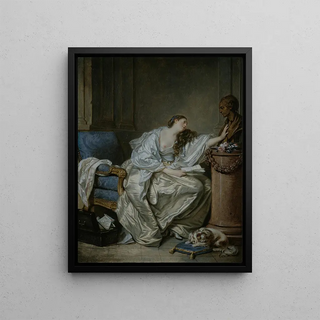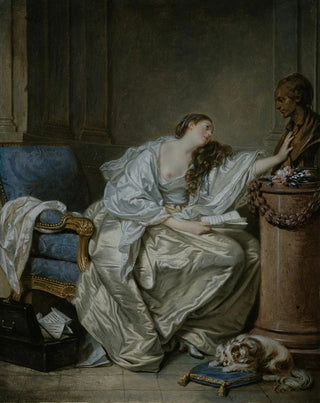Art print | Le tendre ressouvenir Tender memory - Jean-Baptiste Greuze


View from behind

Frame (optional)
In the rich and complex universe of art history, certain works stand out for their ability to capture deep emotions and evoke nostalgic memories. "Le tendre ressouvenir," painted by Jean-Baptiste Greuze, is a perfect example. This canvas, echoing the sensitivity of the 18th century, immerses us in an intimate moment where the viewer's gaze is immediately drawn to the delicacy of the features and the depth of the expressed feelings. Through this work, Greuze manages to establish a dialogue between the past and the present, allowing each person to reconnect with their own memories. The art print of this iconic piece is much more than a simple decorative object; it is an invitation to reflection and emotion.
Style and uniqueness of the work
The uniqueness of "Le tendre ressouvenir" lies in how Greuze manages to combine realism and idealization. The characters, imbued with softness and melancholy, are depicted with such finesse that they seem almost alive. The play of light and shadow, along with the chosen color palette, enhances the emotionally charged atmosphere emanating from the canvas. The child's gaze, both innocent and contemplative, captures attention and invites deep reflection. Greuze, a master of portraiture, transcends mere visual rendering to offer a true introspection on human relationships and the memories that shape them. Every detail, from the subtle smile to the exchanged glances, tells a story—one of tender love and palpable nostalgia.
The artist and his influence
Jean-Baptiste Greuze, an emblematic figure of the Rococo movement, left his mark on his era with his innovative approach to portraiture and genre painting. His work is characterized by a particular sensitivity to human emotions, a trait that sets him apart from his contemporaries. Greuze was able to capture the very essence of family relationships and intimate feelings, which allowed him to reach a broad audience. His influence extended beyond his time, inspiring many artists who sought to explore the complexity of human emotions through their own creations. In "Le tendre ress

Matte finish

View from behind

Frame (optional)
In the rich and complex universe of art history, certain works stand out for their ability to capture deep emotions and evoke nostalgic memories. "Le tendre ressouvenir," painted by Jean-Baptiste Greuze, is a perfect example. This canvas, echoing the sensitivity of the 18th century, immerses us in an intimate moment where the viewer's gaze is immediately drawn to the delicacy of the features and the depth of the expressed feelings. Through this work, Greuze manages to establish a dialogue between the past and the present, allowing each person to reconnect with their own memories. The art print of this iconic piece is much more than a simple decorative object; it is an invitation to reflection and emotion.
Style and uniqueness of the work
The uniqueness of "Le tendre ressouvenir" lies in how Greuze manages to combine realism and idealization. The characters, imbued with softness and melancholy, are depicted with such finesse that they seem almost alive. The play of light and shadow, along with the chosen color palette, enhances the emotionally charged atmosphere emanating from the canvas. The child's gaze, both innocent and contemplative, captures attention and invites deep reflection. Greuze, a master of portraiture, transcends mere visual rendering to offer a true introspection on human relationships and the memories that shape them. Every detail, from the subtle smile to the exchanged glances, tells a story—one of tender love and palpable nostalgia.
The artist and his influence
Jean-Baptiste Greuze, an emblematic figure of the Rococo movement, left his mark on his era with his innovative approach to portraiture and genre painting. His work is characterized by a particular sensitivity to human emotions, a trait that sets him apart from his contemporaries. Greuze was able to capture the very essence of family relationships and intimate feelings, which allowed him to reach a broad audience. His influence extended beyond his time, inspiring many artists who sought to explore the complexity of human emotions through their own creations. In "Le tendre ress






